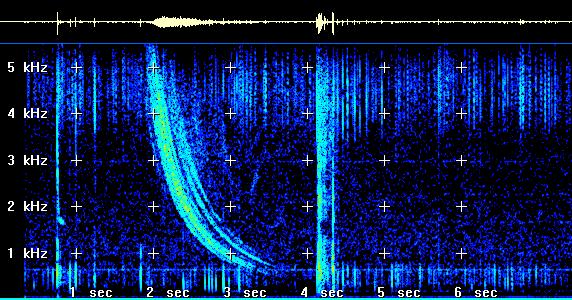
See also my: Ozarkcon 2008 Presentation
Over the years I have enjoyed monitoring the long wave part of the electromagnetic spectrum. To be a little more precise, I'm referring to natural radio emissions in the VLF (Very Low Frequency) range and miscellaneous radio transmissions in the LF (Low Frequency) to MF (Medium Frequency) ranges. Officially the three frequency ranges are designated as follows:
VLF: 3 kHz to 30 kHz
LF: 30 kHz to 300 kHz
MF: 300 kHz to 3000 kHz
In the VLF portion of the spectrum it is easy to listen to the emissions created by the Earth itself. These emissions are generated by many different mechanisms and are often beautiful to listen to. One must get away from man's power grid because harmonics of the 60Hz power system extend well into the kHz region. 5 miles from the power grid are preferred but very difficult to obtain. I've had very quite reception in places such as Mesa Verde National Park in Colorado. Don't be too discouraged though if you can't get too far away. I've recorded strong whistlers while monitoring from my city back yard. I could write a book on all of the different types of emissions to be heard here but for now I'll give just a few examples.
When lightning strikes the Earth electromagnetic energy is generated literally from DC to daylight. The wave lengths is the VLF part of the spectrum are the most interesting. Most of the emissions are heard via traveling waves over the surface of the Earth and at these frequencies they can be heard for thousands of miles. Nearby strikes will sound like any ordinary static crash on your car's AM radio. Distant strikes will sound much different for several reasons. The Earth and it's ionosphere create a sort of spherical waveguide that will efficiently pass frequencies that have a wave length that is short enough to fit between the two. These frequencies usually appear to be about 3 kHz and above. Therefore, you will notice that for distance strikes, frequencies below about 3 kHz will be greatly attenuated. Since neither the Earth nor the ionosphere are perfect conductors there will always be exceptions to this. One fact to note is that shorter wave lengths (higher frequencies) will travel through a plasma faster than a longer wave length. This is only perceivable for frequencies in the VLF where the wave lengths can vary by miles by only a small in frequency. Since the ionosphere is essentially a plasma, it has an interesting effect on distant surface waves. Right near the cutoff frequency of the Earth - ionosphere waveguide, say 3 kHz, a very noticeable delay is perceived in the lowest frequency. What happens is that what started out as a burst of static, energy at all frequencies, now has a noticeable chirp. This is because at the low frequency end of this static burst, the emission is slurred in time. This can make for some interesting sound effects that can very greatly with the state of the ionosphere. There are also plasma trapped in the magnetic field lines that extend from one hemisphere to the other and can extend out several Earth radii. When lightning strikes in one hemisphere, energy somehow (probably via Sprites and Blue Jets) gets coupled into these plasma belts and is propagated to the opposite hemisphere. Again, due to the varying velocity factor with wave length in a plasma, what starts off as an emission at all frequencies at the same time gets filtered in time by frequency at the other end of the path. This creates a very nice descending whistle. If the path is efficient enough, this energy can bounce back and forth between the two hemispheres several times each time creating multiple whistlers, each with a longer duration. This is known as a whistle train.
Below is a spectrogram of a very strong whistler. The vertical response just before the 1 second marker is probably the lightning strike that created the whistler.

There are other sources that generate their own types of emissions. These are auroras which produce a swishing sound, geomagnetic storms in which the Earth's magnetic field quivers like a bowl of Jell-O, and several other sources that are all related to effects from the sun. There have also been manmade emissions from navigational beacon transmissions, land based scientific studies, and from the space shuttle during project Inspire.
The equipment required for reception of these very emissions can be very simple. Essentially, all you need is a high gain audio amplifier. Instead of connecting a microphone you simply connect an antenna. Even though the wave length is measured in miles, you don't need a big antenna. Adequate signal to noise ratio can be obtained with a simple e-field probe (short whip) or a magnetic loop antenna. My VLF receiver I built is based upon a schematic provided by the project "Inspire" and is shown below. It has multiple outputs, microphone input for narrating, switchable high pass filter to greatly reduce the effects of the power grid, and external power, antenna, and ground connections.
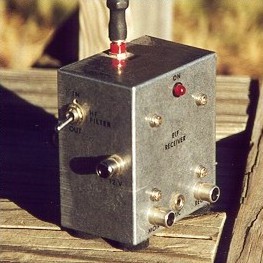
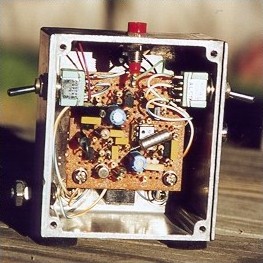

To hear some spectacular recordings for yourself of what is on VLF check out the web site of Stephen P. McGreevy, N6NKS. His recordings must certainly be the best in the world!
The LF part of the spectrum has many different types of man made transmissions. Most of these are navigational beacons that can be looked up by their call signs to find their location. Some nations broadcast AM on these frequencies with very powerful transmitter that can be fun to try to hear. One of the strongest transmissions in this region is from the time/frequency standard WWVB on 60 kHz. Most of my listening activities here center around the no license band from 160 kHz to 190 kHz. Here in the U.S., I believe we may transmit any mode as long as we don't exceed the bandwidth provided and the transmitter power is limited to 1 watt. The antenna is limited to 50 feet in length and this includes the transmission line. Considering the long wave length, these are severe restrictions. Even so, there are many CW and BPSK beacons on the air that have been heard across the nation. The new PSK31 mode may be just the thing for this band.
Here are a few sample recordings of what you may find in the LF region of the spectrum:
BPSK - (33 kB) Binary Phase Shift Keying at 22 kHz
WWVB - (28kB) 60 kHz
Here are a couple of recordings of the LowFER (Low Frequency Experimental Radio) beacon "TEXAS" operated by Bill Cantrell, WD5CVG:
TEXAS AGGIES CW - (237kB) CW on 189.700 kHz at 1450 UTC on May 08, 2000.
TEXAS AGGIES BPSK - (241kB) BPSK on 189.700 kHz at 1526 UTC on May 08, 2000.
Here a couple of notes from Bill Cantrell regarding his beacon:
October 5, 1999
"LowFER Beacon "TEXAS" (Haslet, TX grid EM12) is back to transmitting alternate BPSK and CW on 189.700 kHz. BPSK is sent during the *first* 30 minutes of each hour, and CW (6 wpm) is sent for the last 30 minutes. The BPSK format is MS100, ET1, and the identifier is TEXAS (space) AGGIE (space), with a run length of 12. The CW ID is "TEXAS AGGIES". Frequency and baud rate accuracy are +/- 0.3 parts in 1 billion. EIRP should be good at ~ 5 mW".
February 26, 2001
"At the moment, TEXAS is on 189.090 kHz, and I am about to start running a new BPSK modulation scheme called WOLF by Stewart Nelson."
Below are a few photo QSL cards that I received for my reception of the TEXAS beacon:
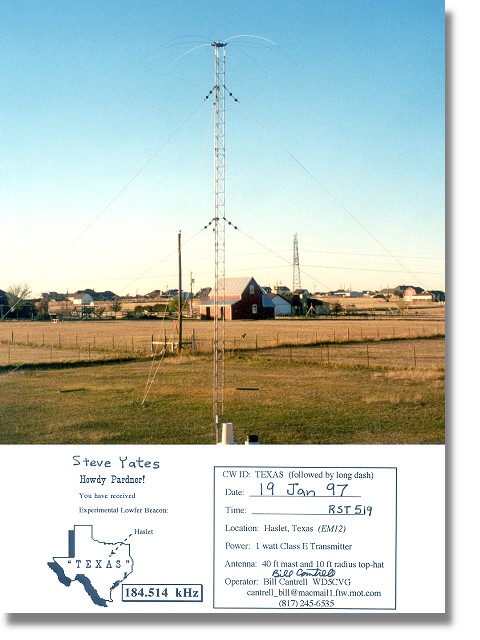


There are several commercially available receivers that can tune this range and it usually doesn't require much of an antenna. The limiting factor here is noise from your local environment. The biggest culprits are dimmer switches, touch lamps, and Chinese battery chargers. These devices can make monitoring this frequency range almost impossible at times. There are antennas to help, such as multiturn loops and magnetic loop antennas wound on ferrite rods. The directional properties of these antennas can be used to null out interference if your lucky.
The receiver I use is a government surplus receiver that was used for surveillance years ago and is shown below. It is a Rycom R1307 A/GR. It is all vacuum tube and has a calibrated field strength meter and step attenuator. It can demodulate CW, AM, SSB, FM, and FSK. It also has a variable BFO and selectable IF bandwidths. The tuning range is from 0 to 830 kHz. It has been a good receiver.
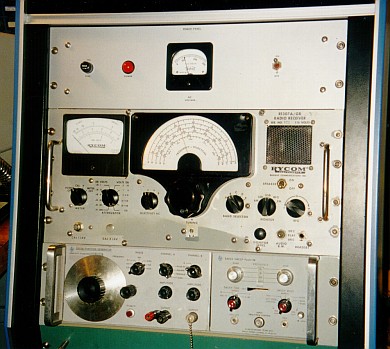
This band is mostly known for the commercial AM broadcast the are from 540 kHz to 1700 kHz. I find it enjoyable to tune around late at night and listen to far away broadcast. Often times stations will rebroadcast shows from the 1930's to 1950's and it is very nostalgic to sit beside my 1930's RCA radio console and listen to these transmissions. Even though I wasn't even thought of yet when these broadcast occurred the first time (for that matter, the second and third times), I can get a sense of what it must of been like.
There are also commercial air navigation beacons on the low end of the MF spectrum that can be interesting to listen to. I have often monitored CW (Morse) traffic from ship to shore stations from about 400 to 530 kHz.
Individuals have put some beacons in the AM broadcast band and have received reports from great distances. I believe these unlicensed transmissions are limited to 100mw and a 10 foot antenna here in the U.S. There may be a field strength limitation on that too.
One must not forget about the amateur band from 1.8 to 2.0 MHz. This is often referred to as the "top band" or "gentlemen's band". It is the amateur band with the longest wave length (160m) and the hams found there are often amongst the most courteous. This band used to be quite popular for mobile work during the daylight hours even though the mobile antennas were very much a compromise. It is possible to work about anywhere on 160m. Around the world propagation is possible in the winter months along gray line paths (along the day/night terminator). Summer time propagation is limited by atmospheric noise due to lightning.
Here in Texas, I can often hear Spanish speaking stations in the 2 to 3 MHz region on AM. I believe these are from ships in the Gulf of Mexico. At one time AM was quite popular in this frequency region for ship to shore communications.
I can't forget about WWV on 2.5 MHz. This is the lowest frequency of transmission for this time/frequency standard transmitting from Boulder, Colorado using the call WWV. It can always be heard here in Texas at night.
In general the low frequencies are often forgotten about by the average ham and SWL. It is often thought that a very large antenna is needed. This can be true for efficient transmitting but for receiving a small antenna with some useful nulls in its pattern is preferred.